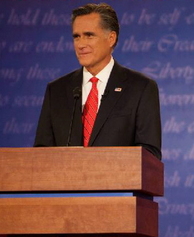Town Hall Format Blunts Romney’s Rhetoric of Argumentation by Enumeration
Romney rattles off only four of his patented series of bullet-point answers at the Hofstra debate versus 10 in Denver

Meanwhile, Governor Romney – certainly well-rehearsed from 19 debates conducted during the GOP primary phase and over a year giving stump speeches on the campaign trail – rattled off his arguments and policy positions in a confident, rat-a-tat, bullet-point style.
Over his 38-plus minutes of speaking time in Denver, the former Massachusetts governor presented 10 PowerPoint-esque aural slides enumerating plans ranging from as few as two points (how he would replace Obamacare) to as many as five (the broad strokes of his economic plan).
And in case the audience lost track (and perhaps to ensure that he did not), Romney almost always numbered each point along the way.
“My plan has five basic parts. One, get us energy independent, North American energy independent. That creates about four million jobs. Number two, open up more trade, particularly in Latin America; crack down on China if and when they cheat. Number three, make sure our people have the skills they need to succeed and the best schools in the world. We’re far away from that now. Number four, get us to a balanced budget. Number five, champion small business.”
During the town hall debate Tuesday evening at Hofstra University, Romney attempted to pick up where he left off in Denver in terms of his rhetorical strategy.
When asked by a college student in the opening question what he would do to ensure he could support himself after graduation, Romney replied:
“So what we have to do is two things. We have to make sure that we make it easier for kids to afford college. And also make sure that when they get out of college, there’s a job.”
But the town hall format – in which it is more difficult for candidates to ignore the questions asked of them than if asked by a moderator – as well as more interruptions by the President made it difficult for Romney to continue to debate utilizing a laundry-list rhetorical format.
It would be well into the second half of the debate before Romney would revisit this argumentative style.
The second time Romney attempted his bullet-point list was in response to a question by an audience member of how he was different from President George W. Bush. In doing so, he discussed his 5-point plan – but was a bit rattled and only remembered to mention four points:
“President Bush and I are — are different people and these are different times and that’s why my five point plan is so different than what he would have done… my policy starts with a very robust policy to get all that energy in North America — become energy secure. Number two, trade — I’ll crack down on China, President Bush didn’t…Number three, I’m going to get us to a balanced budget…And then let’s take the last one, championing small business.”
Overall, Romney offered only four bullet-point answers during his 40+ minutes of speaking time at Hofstra – six fewer than in Denver – and three of these were abbreviated to just two points each.
Mitt Romney Enumerated Answers During the First Two Presidential Debates
|
1st Debate
|
Points
|
1
|
2
|
3
|
4
|
5
|
|
Economic plan
|
5
|
Energy independence
|
Open trade / tough on China
|
Increase workforce skills
|
Balanced budget
|
Champion small business
|
|
Economic plan
|
4
|
State control of education
|
Reduce taxes & exemptions
|
Energy independence
|
No tax cut adding to deficit
|
|
|
Tax plan
|
3
|
No tax cut adding to deficit
|
No reduction for high income
|
No tax increase on middle income
|
|
|
|
Tax plan
|
2
|
No tax cut adding to deficit
|
Reduce rates & exemptions
|
|
|
|
|
How to cut deficit
|
3
|
Raise taxes (no)
|
Cut spending (yes)
|
Grow economy (yes)
|
|
|
|
Where to cut spending
|
3
|
Is program worth borrowing from China to pay for it?
|
Program run more efficiently by states
|
Make federal govt more efficient
|
|
|
|
How to save Medicare
|
3
|
No change for current & near-retirees
|
Young choose Medicare or private plan
|
Means test benefits for income
|
|
|
|
Why repeal Obamacare
|
4
|
Too expensive
|
Cuts Medicare
|
Unelected board
|
Hurts job growth
|
|
|
Replace Obamacare
|
2
|
Cover preexisting conditions
|
Young stay on family’s plan
|
|
|
|
|
Role of government
|
2
|
Protect life and liberty
|
Religious tolerance
|
|
|
|
|
|
|
|
|
|
|
|
|
2nd Debate
|
Points
|
1
|
2
|
3
|
4
|
5
|
|
Financial security for college grads
|
2
|
Make college affordable
|
Creating jobs
|
|
|
|
|
Economic plan
|
4
|
Energy independence
|
Open trade / tough on China
|
Balanced budget
|
Champion small business
|
|
|
Immigration
|
2
|
Support legal immigration
|
Stop illegal immigration
|
|
|
|
|
Bring jobs back to USA
|
2
|
China abides by fair trade
|
Make USA attractive to entrepreneurs
|
|
|
|
Table compiled by Smart Politics.
Follow Smart Politics on Twitter.
